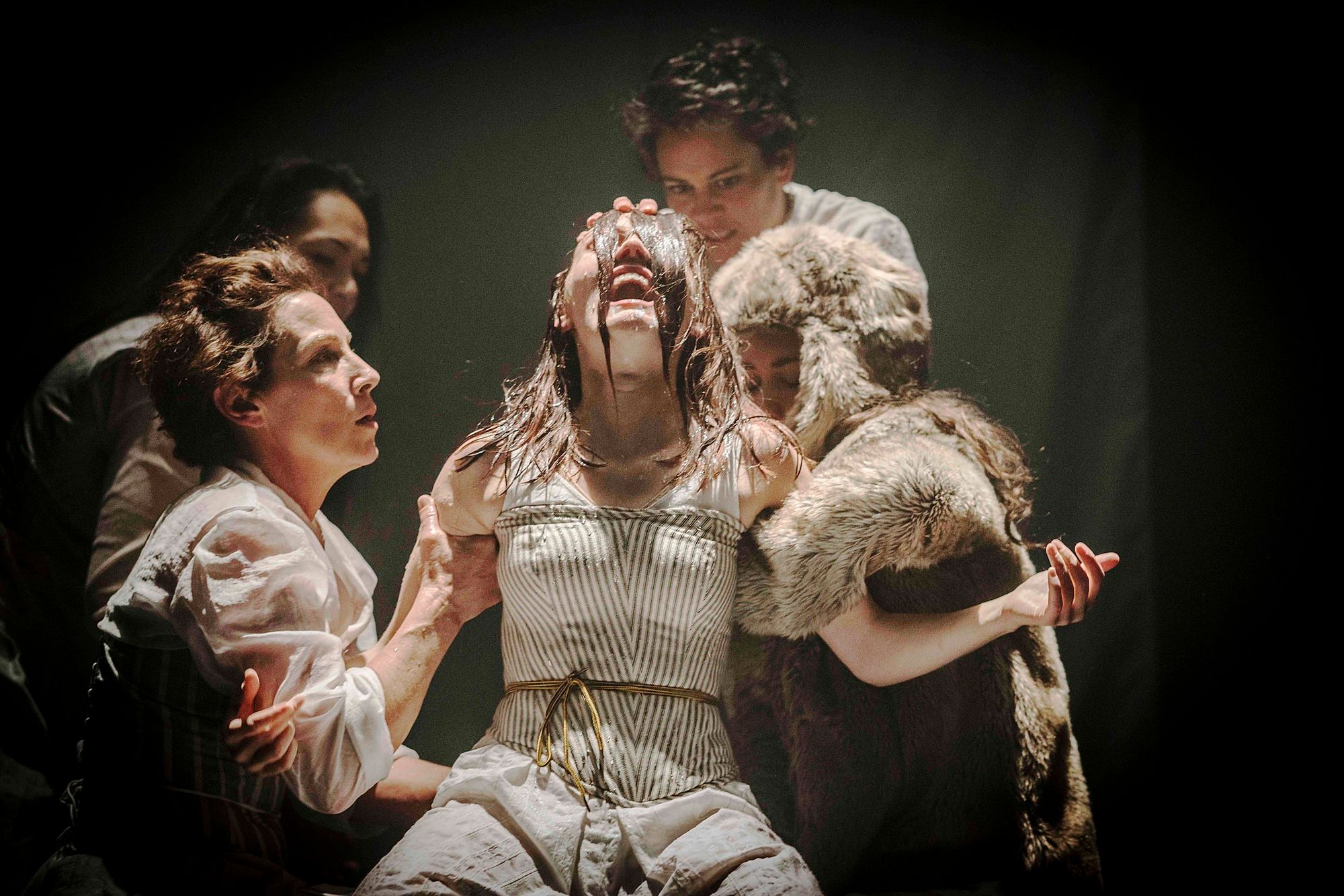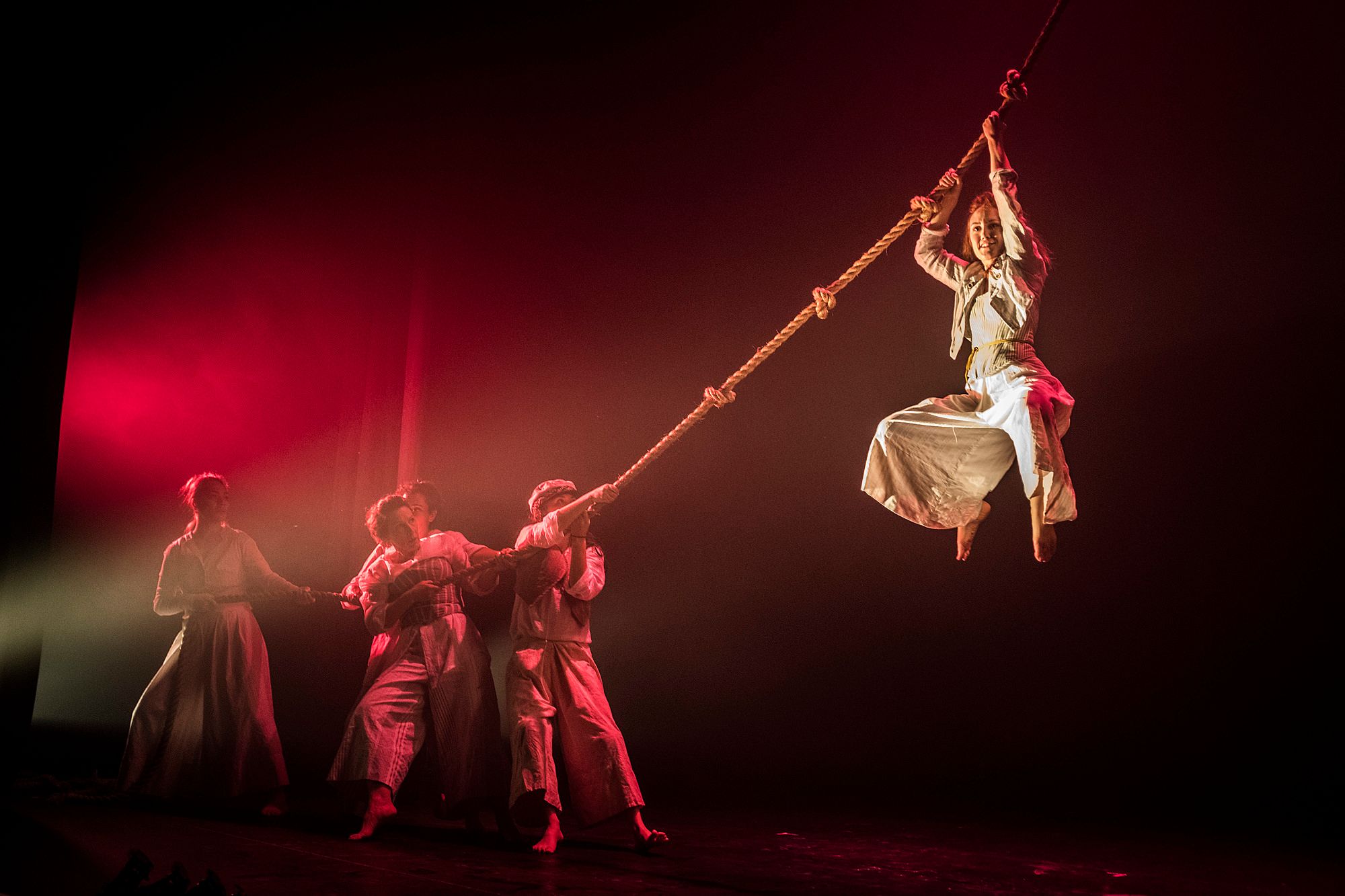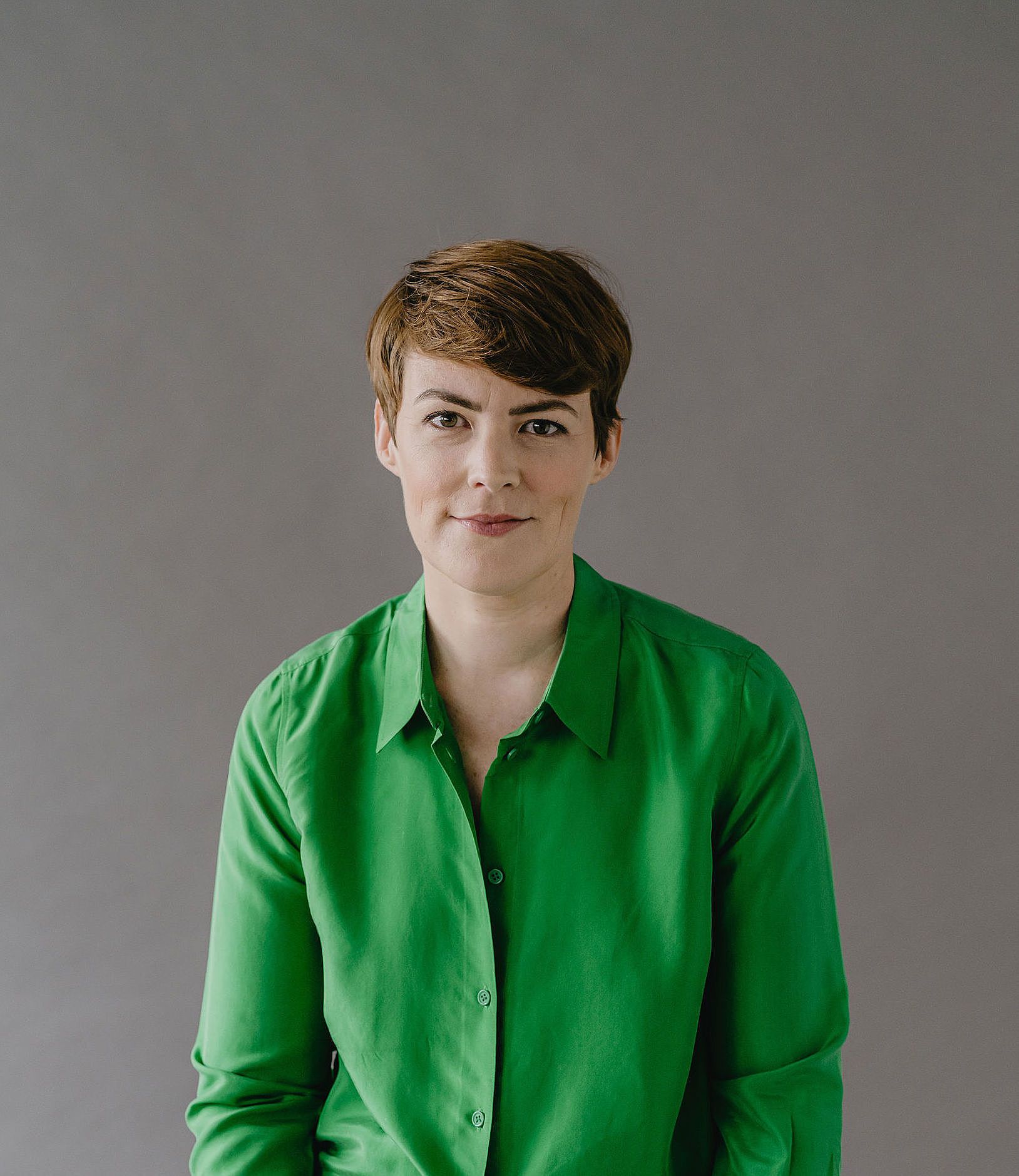Near Magic: A Review of Kororāreka: The Ballad of Maggie Flynn
Kate Prior finds the new work from Red Leap Theatre Company to dazzle but confuse.
A new work from Red Leap Theatre Company sees them collaborating with playwright Paolo Rotondo, who has drawn from several histories to create Maggie Flynn, a fiery survivor whose story is told in a production which, as Kate Prior finds, both dazzles and confuses.
The most starkly arresting image in Kororāreka: The Ballad of Maggie Flynn occurs around the halfway mark. A sheet is ripped from a central rig to reveal two harshly-lit dead bodies hanging upside down. Milky water streams down through their hair and onto the floor. It’s surprising and breathtaking. The music haunts. At this exact moment, the woman behind me whispers to her friend, "I don’t understand". Those three seconds underscore my experience of this new work from theatre company Red Leap: so many beautiful images, so much that’s not quite clear.
Kororāreka: The Ballad of Maggie Flynn, by Paolo Rotondo and Red Leap Theatre Company is a rambling journey with fictional colonial hero Maggie Flynn (Victoria Abbott), a composite character from various true histories. After two viewings, some narrative details are still elusive, but this is the skeleton: Maggie travels from Ireland to Australia a convict, but finds herself captaining a whaling ship to New Zealand. Her husband dies on board, and she lands in what was known as the wildest and most lawless place on Earth, Kororāreka, to bury him. She then meets and marries a Māori rangatira, Mata (Miriama Mcdowell), who is later killed. Some children or goats die at that point too (I’m not sure which). The story ends with Maggie, now a madam in a brothel, haunted by the kehua of her past, but determined to remain in Kororāreka until she dies.
Red Leap work within a devised theatre tradition which sees the aesthetic deeply anchored in rehearsal room choices. The bodies onstage are in a constant relationship with the only piece of set, John Verryt’s movable square black rig. It’s clambered up and down and over by the actors and becomes a screen for projections of inky, scratchy drawings. At various points it's a ship, a Māori pā and a brothel. The strong, hard lines of this black jungle-gym and the long white rākau which the performers intermittently wield are set against a junky, anything-that-comes to-hand performance aesthetic (including an old sleeping bag as the rangatira’s korowai and laundry baskets as skirt bustles). The performance space swiftly expands and contracts; Rachel Marlow’s angled lighting at once accentuating the bare stage space then returning it to cramped, sometimes increasingly smaller, boxes. It keeps the eye moving, but it’s curious why Red Leap have stuck with their usual formal end-on configuration for such an ensemble-focused work, in which the performers are balladeers who signal their task of storytelling and seem to frequently want to break free of this flat presentational style.
Kororāreka is a bold and ambitious work which marks an exciting new step for this company – bringing their devised processes to a piece of new writing. No one in New Zealand makes theatre like Red Leap. Their large-scale, rich, visual work is picked up by festivals around the world, and there’s a reason why the images here are so stunning: director Julie Nolan has a sharp eye for that sense of a frozen waterfall – the crystalline moment of first encounter with an image. But theatre is made up of moving, not frozen, parts and there’s something about the way the elements struggle to cohere in Kororāreka that stops me from being inside each moment. That could be because these wayward, wily balladeers feel like they should be in a freer space than this traditional configuration, but there’s also a confusion of rhythms and metaphor, which in turn hazes the text and the narrative.
There’s a reason why the images here are so stunning: director Julie Nolan has a sharp eye for that sense of a frozen waterfall – the crystalline moment of first encounter with an image.
What does the ‘ballad’ of the show’s title mean? Rotondo’s script definitely echoes folklore and the hero's epics that were the stuff of ballads, and the performance gathers all the bawdy energy you might associate with that name. A ballad may or may not rhyme, and it could be in poetic or song form, but essentially it has rhythm at its core. Kororāreka appeals to this, but its own dramaturgical rhythms are confused or unbalanced. Comic set pieces are followed by more comic set pieces, pushing them into major-chord focus, so that by the time we’ve returned to the central story we’ve lost where we are. Or all of a sudden a weak comic character from one scene is immediately required to provide all of the menace of bringing death in an important consecutive scene.
It’s a curious thing to be on the brink of a moment of magic, to feel that glimmer, but to be denied the full flourish. Like magic, metaphor requires two counterweights – the poetic and the literal – working in balance, and the punch takes place in the gap between perception and imagination. But moments of magic need to be fired by narrative truths. In Kororāreka, there are disconnects in the visual metaphors; between what we’re seeing and what we could believe. This manifests in that striking image of death described above, but what leads to this moment is a muddy mix of children and goats (?) and by the time we reach it, we don’t know what we’re looking at – the bed of narrative to support it is fragile. Have the goats or the children died? At another point, Alison Bruce plays a French settler who’s wanting to do business with Maggie and presents her with a Bible. The French man holds out a block of Lindt chocolate. So the block of Lindt chocolate is a Bible. I’m with ya. But then the actor breaks that which she’s set up and eats the chocolate. What does it mean when you eat the Bible? Is that the intention?
It’s infinitesimal, this stuff, but it’s not just theatre tricks gone rogue. It all feeds into our understanding of the story. In Rotondo’s script, the core of Maggie’s struggle seems to be the loss of a child. In the staging, this is picked up by a recurring image of a performer holding the coiled end of a giant rope which hangs from the rig, as a crying baby in their arms. The allusion is an umbilical cord, but the fact it sometimes rises to the ‘sky’ instead of being a constant, inescapable tug from the land seems a lost opportunity (whenua translates as both land and placenta, and the image wants for further treatment, especially if this struggle represents our central character’s driving force – what she's 'running from'). By the time the blunted ending comes around, I'm not sure where Maggie is in this emotional journey. This confusion of visual metaphors and the broken rhythms in the dramaturgy mean the core focal points of the story (the love between rangatira Mata and Maggie, and the eventual loss of all she holds dear) don’t hold the narrative weight they feel they should.
I’d suggest the script conveniently sidesteps the wreckage of colonialism, and history comes out relatively clean.
All five performers (Awhina Ashby and Katrina George round out the ensemble) work as a muscular, playful company, flicking between storytelling and dialogue with joyful ease. Their energy is catching. There’s potency in seeing five women in full physical flight onstage, and while these actors do an incredible physical job, the confusion of story isn’t helped by a series of loose accents and strained voices. There’s a sense that some performers are pushing their voice through the gravel of their lower register to achieve a sense of power, which has the opposite effect. (Our voices don’t necessarily need to go deep to have power. That’s just an old patriarchal legacy. Our voices can be ours).
Using an outside text carries the risk that it’s approached as a separate entity from what happens in the space. But the word ‘text’ comes from the word ‘to weave’ and it's just like any other texture (light, sound, bodies, space) to be woven into any work; no higher or lower in a hierarchy of elements. Julie Nolan, her design team and the ensemble do an often jaw-droppingly beautiful job of firing Rotondo’s script with life, but sometimes the weft and warp of the fabric gets loose.
One more thing. Nolan notes in her programme that Rotondo’s story is based on our ‘messy bicultural past’. Yet I’d suggest the script conveniently sidesteps the wreckage of colonialism and history comes out relatively clean. So aside from the fact that this is a strong ensemble of five women telling a New Zealand woman’s history with welcome irreverence, one other big question hangs over the entire work for me: is this moment the time for a relatively apolitical hero story of a swashbuckling dominant-culture colonial, who, when other Māori characters die around her, remains a survivor?
Kororāreka: The Ballad of Maggie Flynn runs from June 9-17 at Q Theatre, then tours to Russell, Kerikeri and Whangarei. More information here.





